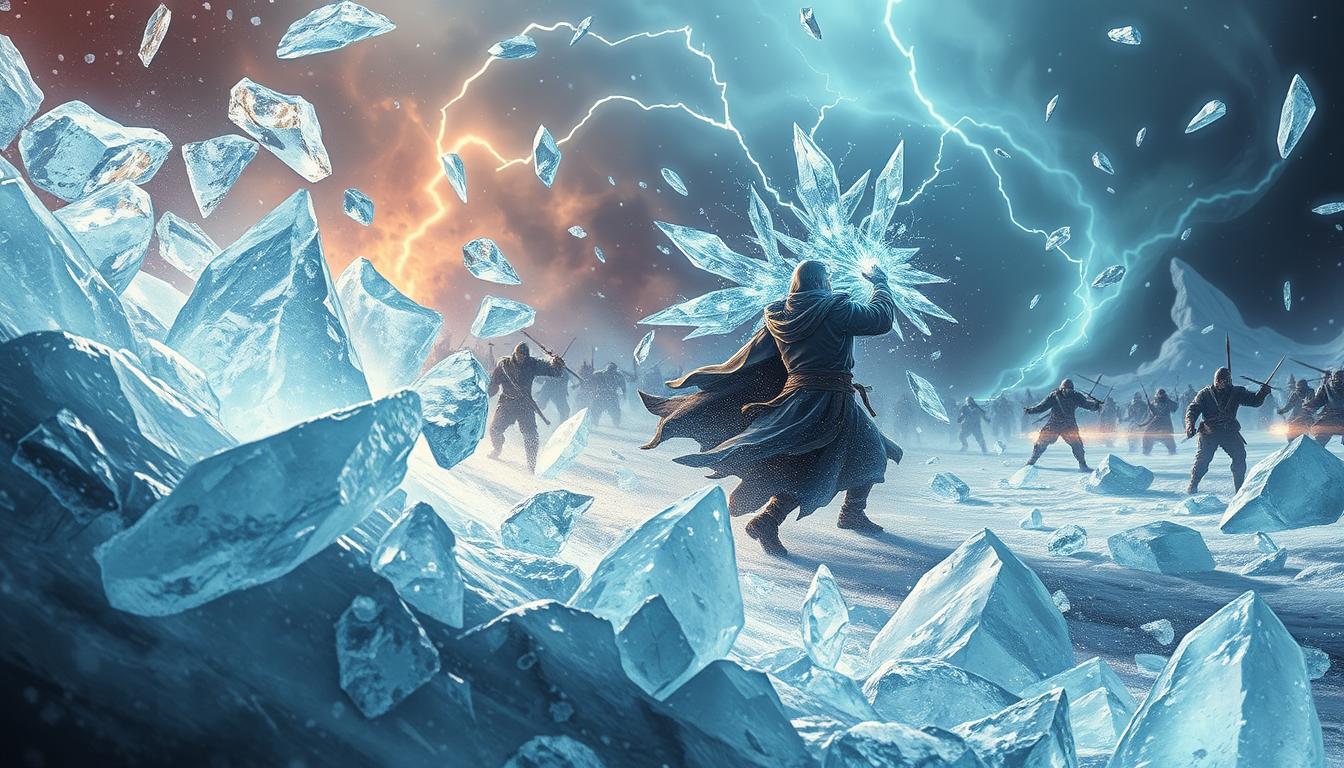Ice Storm 5e: My Ultimate Guide to Rules and Strategies

Want to know when a hail-based evocation outplays a classic fireball? I ask that because this spell trades raw burst for control, range, and a terrain effect that shifts battles on multiple levels.
I’ll lay out the rules, the exact area and effect, and why I use it in real fights. At a glance: it makes a 20-foot-radius, 40-foot-high cylinder at up to 300 feet, forces Dexterity saves, and deals 2d8 bludgeoning plus 4d6 cold on a failed save or half on success.
What matters to me is the difficult terrain left behind until the end of my next turn, the vertical coverage, and how the mixed damage can bypass some resistances. I’ll also cover who gets this spell, friendly-fire etiquette, and combos that turn control into kills.
Key Takeaways
- Control over peak damage: This 4th-level evocation favors reliable battlefield shaping over single-roll bursts.
- It creates difficult terrain in a 20-ft radius, 40-ft high cylinder at 300 ft range.
- Damage is 2d8 bludgeoning + 4d6 cold; upcasting adds +1d8 bludgeoning per slot.
- Works on allies and foes—positioning and table etiquette matter.
- Great for vertical fights, ships, and combos with Web or Thunderwave.
How I Use Ice Storm 5e in Real Games
I favor this cast when I need to force the battlefield to slow down and give my team room to breathe. The spell’s wide, tall cylinder and long range let me shape fights from a distance.

Why I prep it over flashier picks
I pick this spell when tempo and control beat raw numbers. The area becomes difficult terrain until the end of my next turn, which halves movement for creatures that pass through it.
The mixed damage is fine, but the real win is denying routes and slowing flyers. I also respect the saving throw—everyone in the cylinder can be affected, allies included—so I plan placement carefully.
My go-to scenarios: kiting, area denial, and crowd control
- I drop it between my team and a mob to start a kite and force slow retreats.
- When I expect foes in the air, the spell turns the air into a slog and clips flying tactics.
- It covers stairs, balconies, and ships well—multi-level control is its strength.
- I use it to buy rounds for ranged allies, trading slightly less damage for a huge positional advantage.
Ice Storm 5e Rules: What the Spell Actually Does
Let’s break down the mechanics so you can use the spell reliably in play.
I measure the area as a 20-foot radius and a 40-foot-high cylinder centered on a point within 300 feet. That vertical reach makes the area effect great for multi-level fights.
Each creature in that cylinder must make a Dexterity saving throw. On a failed save the creature takes 2d8 bludgeoning damage and 4d6 cold damage; on success it takes half. Both damage types use the same saving throw.
The hail created by the spell turns the volume into difficult terrain until the end of my next turn. This difficult terrain applies to ground and air inside the cylinder, so flyers get slowed too.
Components and range matter: V, S, M (a pinch of dust and a few drops of water) and 300 feet range. You can cast this underwater. Upcasting adds +1d8 bludgeoning per slot above 4th, which raises the spell’s reliable bludgeoning damage.

| Feature | Value | Notes |
|---|---|---|
| Area | 20-ft radius, 40-ft high | Good for stairs and flying foes |
| Save | Dexterity saving throw | Single save applies to both damage types |
| Damage | 2d8 bludgeoning + 4d6 cold | Half on success; +1d8 bludgeoning per slot upcast |
| Terrain | Difficult terrain until end next turn | Applies in both air and ground |
Tactical Plays I Rely On with Ice Storm
When I want to bend a fight’s tempo, I reach for this spell to reshape where creatures can and cannot move. The cylinder’s vertical reach and long range let me force choices from a distance.

Pin flyers and control multiple levels: I drop the cylinder to cover the altitude foes use, cutting their air speed and making them decide between dashing or losing attacks. The difficult terrain applies to both air and ground, so flyers feel it too.
- I block stairs and balconies to hit stacked groups that flat areas miss.
- I start hit-and-run turns: cast, move, and let the terrain tax enemy movement so my ranged team keeps firing.
- I warn melee allies not to charge through the area—crossing it slows them and may expose them to initial damage.
- On ships or gangplanks I line the cylinder along choke points so foes waste movement reaching us.
- I pair elevation with forced movement spells to push enemies back into the area effect for extra control.
Trade-off: I accept some lost burst in exchange for control—over two rounds the effect usually nets more team damage and safer positioning.
Ice Storm vs. Spells Like Fireball and Lightning Bolt
When I pit this evocation against classic blast spells, I weigh control, range, and vertical reach — not just raw numbers.
Damage trade-offs vs. control value
I know fireball and lightning bolt (3rd level) average about 28 damage on a failed save. By contrast, the spell ice storm (storm 4th level) averages roughly 23 on a failed dexterity saving throw: 2d8 bludgeoning plus 4d6 cold.
That 5-point gap is real, but so is the terrain benefit. Difficult terrain lasts until the end of my next turn, which changes enemy movement and targeting for two rounds.
When the Z-axis makes the difference
The 40-foot-tall cylinder tags upper walkways and flying creatures that a sphere or line might miss. The 300-foot range also lets me open fights from farther away than most blasts.

| Spell | Average damage | Key advantage |
|---|---|---|
| Fireball / Lightning Bolt (3rd) | ~28 | Higher raw burst, clean area clear |
| ice storm (storm 4th level) | ~23 (2d8 bludgeoning + 4d6 cold) | Difficult terrain, tall cylinder, longer range |
| Upcast ice storm | +1d8 bludgeoning per slot | Closes damage gap vs like fireball while keeping control |
- I pick ice storm when vertical fights or control matter more than pure burst.
- Dual damage types beat single resistances more often.
- I swap back to fireball or bolt in tight corridors where line or sphere wins.
Combos, Classes, and Creative Uses
I treat the spell as a terrain anchor and then add follow-up effects to lock foes in place.
Who gets access matters: Druids, Sorcerers, and Wizards can learn this, and a few subclasses keep it ready. Tempest Domain Clerics, Circle of the Land (Arctic) Druids, Oath of the Ancients Paladins, and Artillerist Artificers often have it prepared or easy to pick up.
How I layer control: I cast ice storm as a base and then drop Web where the cylinder landed. Creatures slowed by the difficult ground usually fail sticky saves and stay trapped.

- I pair Storm Sphere to create two aerial slow zones and split flyers.
- I shove or use Thunderwave to force enemies back into the lingering hail and tax their next turn.
- I funnel foes toward fire or other hazards so they must choose between two bad options.
- On ships I target rigging and decks to halt pursuit while my crew recovers.
| Use | Best Caster | Effect |
|---|---|---|
| Control layering | Wizard / Sorcerer | Combine with Web, Storm Sphere for double slow |
| Always-prepared builds | Tempest Cleric / Arctic Druid | Reliable pick for vertical maps and sea fights |
| Forced movement combos | Druid / Artificer | Thunderwave or shove pushes creatures into the area |
Flavor tip: I narrate hail as condensed evocation energy, which sells the scene without changing the rules. That helps keep the table engaged and the tactic clear when I cast ice storm in play.
Conclusion
In practice, the real value comes from forcing routes and timing moves around the effect’s window. I judge success by how many foes I slow and how my team uses the pause.
, This evocation creates a 20-foot radius, 40-foot-high cylinder at 300 feet and deals 2d8 bludgeoning plus 4d6 cold on a failed Dexterity saving throw (half on success). It also makes the area difficult terrain until the end of your next turn, and that terrain applies to air and ground.
Use it when you want reach and control over raw burst. I plan movement, call lanes for allies, and keep the rules tidy so every creature makes a Dexterity saving roll. Upcast to add +1d8 bludgeoning if I need extra damage while keeping the terrain advantage.